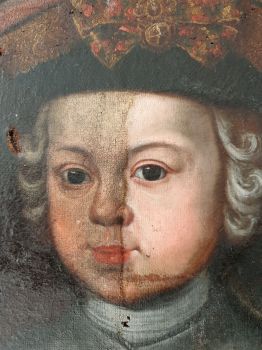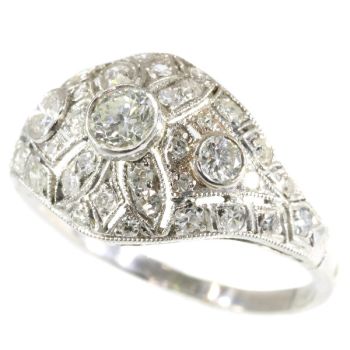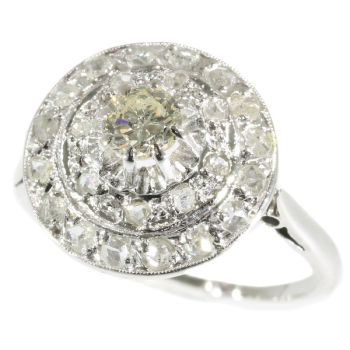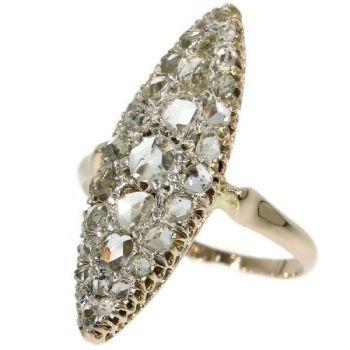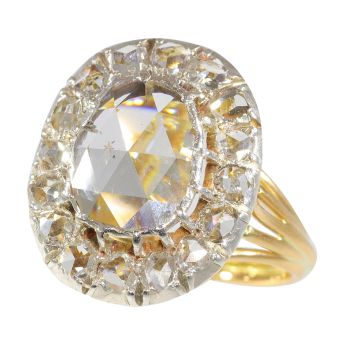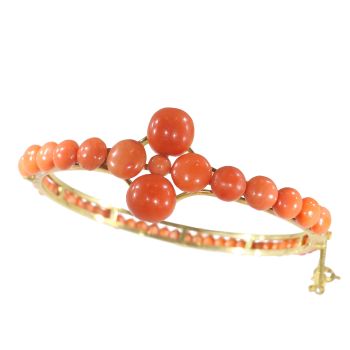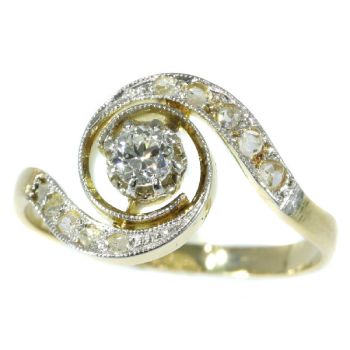Antique 18K Gold Baroque Wedding Band, Circa 1700 – A Timeless Symbol of Love 1700
Artista Desconhecido
Ouro
€ 8.200
Adin Fine Antique Jewellery
- Sobre arte
Imagine wearing an antique wedding band from circa 1700, a rare piece crafted in 18K yellow gold, with alternating lozenge shapes and stylised floral motifs set upon delicate filigree wirework. This beautiful ring, with its Baroque charm, is not just apiece of jewellery; it’s a tangible connection to history, symbolising the enduring nature of love. To wear such a ring as a symbol of your marriage is to carry a piece of timeless elegance, a link to centuries past, as you begin your own journeytogether.
Antique jewelry object group
ring, wedding band
Condition
very good condition
more info on our condition scale
Country of origin
Netherlands
Style
Baroque - Baroque is an artistic style that dominated Europe from the late 16th century to the early 18th century. Often described as "the leading style in European art between the Mannerist and Rococo periods, characterised by dynamic movement,heightened emotion, and bold expression."
Find more info on Baroque
more info on styles
Style specifics
Baroque is a style in art and decoration that developed shortly before 1600 and remained current in Europe until the emergence of the Rococo style c.1730. It was started in Italy, and spread to Germany, Austria, the Low Countries, and Spain andPortugal, with only a somewhat severely classical version being popular in France under Louis XIV. The style was a development of the Renaissance style and is characterized by lively, curved, and exuberant forms, by vigorous movement, and by richornament, based on classical sources, being symmetrical as distinguished from the asymmetry of the following Rococo style.
Period
ca. 1700
Events & facts of this era, poetry of this era, fashion of this era.
Material 18K
warm yellow gold (touchstone tested)
more info on precious metals
Technique
This jewel features a filigree decoration, which is in fact thin gold wire twisted into refined motifs, in this case elegant little balls. You can also notice the use of granulation on this piece. Granulation is a technique where the goldsmith uses very small balls (granules) of metal, which are not soldered to the piece but welded. Both techniques demand very high skills and precision from the maker.
Hallmarks
On the outside of the ring is a hallmark from the Kingdom of the Netherlands, a flowered letter V, used for foreign and small domestic works between 1814 and 1831. On the inside, there are older hallmarks that require further research, but one appears to resemble a 'U' shape, with a standing lozenge between the open arms of the 'U', possibly encircled by a halo-like feature (possibly a year letter?). The distinct character of these marks suggests that the ring could date back to around 1700.
more info on hallmarks
Dimensions
band width 0,75 cm (0,30 inch)
see picture with a ruler in millimeters and inches
Weight
4,30 gram (2,76 dwt)
Ring size Continental EU: 62 & 19¾ , Size USA: 10 , Size UK: T½
Resizing
Resizing is possible but because of the age of the ring we prefer to leave it untouched. Return policy on this ring is not valid anymore once this work has been done.
more info on ring sizes
Adin Reference Nº
24121-0313
Copyright photography
Adin, fine antique jewellery
Additional information
our latest acquisitions
jewelry glossary
wall of fame
visit us in Antwerp
subscribe to our mailinglist
- Sobre artista
Pode acontecer que um artista ou criador seja desconhecido.
Algumas obras não devem ser determinadas por quem são feitas ou são feitas por (um grupo de) artesãos. Exemplos são estátuas dos tempos antigos, móveis, espelhos ou assinaturas que não são claras ou legíveis, mas também algumas obras não são assinadas.
Além disso, você pode encontrar a seguinte descrição:
•"Atribuído a …." Na opinião deles, provavelmente uma obra do artista, pelo menos em parte
• “Estúdio de…” ou “Oficina de” Em sua opinião um trabalho executado no estúdio ou oficina do artista, possivelmente sob sua supervisão
• "Círculo de ..." Na opinião deles, uma obra da época do artista mostrando sua influência, intimamente associada ao artista, mas não necessariamente seu aluno
•“Estilo de…” ou “Seguidor de…” Na opinião deles, um trabalho executado no estilo do artista, mas não necessariamente por um aluno; pode ser contemporâneo ou quase contemporâneo
• "Maneira de ..." Na opinião deles, uma obra no estilo do artista, mas de data posterior
•"Depois …." Na opinião deles uma cópia (de qualquer data) de uma obra do artista
• “Assinado…”, “Datado…” ou “Inscrito” Na opinião deles, a obra foi assinada/datada/inscrita pelo artista. A adição de um ponto de interrogação indica um elemento de dúvida
• "Com assinatura ….”, “Com data ….”, “Com inscrição ….” ou “Tem assinatura/data/inscrição” na opinião deles a assinatura/data/inscrição foi adicionada por outra pessoa que não o artista
Você está interessado em comprar esta obra de arte?
Artwork details
Related artworks
- 1 - 4 / 12
Artista Desconhecido
Een Gotische zuidelijke Nederlanden wandklok1580 - 1590
Preço em pedidoNico van den Assem restauratie
Artista Desconhecido
Copo de beber Cristallo façon de Venise1600 - 1650
Preço em pedidoPeter Korf de Gidts - Antiquairs
Artista Desconhecido
A gem-set ivory sculpture of an Ottoman sultan1700 - 1750
Preço em pedidoZebregs & Röell - Fine Art - Antiques
Peter Paul Rubens (circle of)
Portrait of a man dressed up as an oriental man1620 - 1630
Preço em pedidoGallerease Selected
1 - 4 / 24- 1 - 4 / 24
- 1 - 4 / 24
- 1 - 4 / 12









